Spanish philosophy
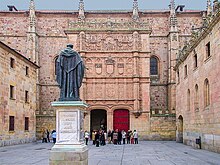
Spanish philosophy is the
Spanish philosophy reached its peak between the 16th and the 17th century.
Another school of thought, the School of Madrid, founded by José Ortega y Gasset included thinkers like Manuel García Morente, Joaquim Xirau, Xavier Zubiri, José Luis Aranguren, Francisco Ayala, Pedro Laín Entralgo, Manuel Granell, Antonio Rodríguez Huéscar and their most prominent disciple, Julián Marías.[4][5]
More recently, Fernando Savater, Gustavo Bueno, and Antonio Escohotado have emerged as prominent philosophers.[6]
Medieval philosophy
Isidore of Seville
(
At a time of disintegration of classical culture,
His fame after his death was based on his Etymologiae, an etymological encyclopedia that assembled extracts of many books from classical antiquity that would have otherwise been lost. This work also helped standardize the use of the period (full stop), comma, and colon.[9]
Since the early Middle Ages, Isidore has sometimes been called Isidore the Younger or Isidore Junior (Latin: Isidorus iunior), because of the earlier history purportedly written by Isidore of Córdoba.[10]
Petrus Hispanus
(
Ramon Llull
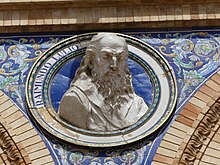
Ramon Llull was born in
Lullism
At his death, Llull left three complete collections of his works (at Genoa, Majorca and Paris), entrusting his disciples with the task of continuing to propagate them. The Parisian centre was associated with the Chartreuse of Vauvert, where a synthesis of his philosophical teaching was made. The Genoese nucleus was linked to the
Arnaldus de Villa Nova
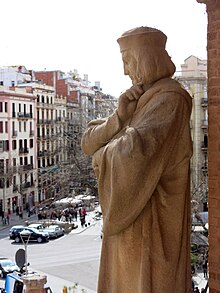
Arnaldus' early biography is poorly known. Although his date and place of birth are unknown, Arnaldus called himself a Catalan and from boyhood he lived at Valencia, in the territories recently reconquered by James I. In 1260 he was a student at the University of Montpellier. After 1280, having left Valencia for Barcelona, he became doctor to the royal house of Aragon-Catalonia and frequented the Dominican studium linguarum. In 1282 he translated Galen's De rigore, iectigatione et spasmo, and from 1290 he was a master of medicine at the University of Montpellier. He formed confidential relations with the sons of Peter the Great, in particular James II and Frederick III. It was during a diplomatic mission to Paris for James that he published his De tempore adventus Antichristi (1300). From this time on, his spiritual commitment increased: he had to sustain grave conflicts with the masters of the university, then with the Order of Preachers. Arnold was doctor to Pope Boniface VIII in 1300, then to the royal house of Provence and Pope Clement V, with whom he was connected even before he became pope. Counting on this set of relationships, he tried to assume the role of spiritual and political reformer, but his programme had some application only in Sicily. After his death and with the accession of John XXII, new attacks began on his work, which was condemned by a provincial court at Tarragona in 1316, even though, since the time of Boniface VIII, the pope had reserved the examination of Arnold's writings for himself. Arnold circulated collections of his writings, partly using his own private scriptorium, partly with the help of James II (at the University of Lleida) and Frederick III (at the Sicilian court). These summae were addressed to a wide public and brought together texts in Latin and/or the vernacular. Some of these collections, in accordance with his proposed programme of conversion, were translated into Greek. More occasional was his circulation of lectures and advice for Beguines while his frequent writings defending himself against the ecclesiastical and civil authorities were circulated in the same way as his spiritual works. Much of his theological output was destroyed after the condemnation of 1316, and important works like the Alia informatio beguinorum have survived only through the documentation of notaries. His numerous medical works consist of translations from the Arabic as well as writings on medical training, natural philosophy, clinical practice and hygiene. They were circulated through the traditional channels of the School or dedicated to important persons, and were in great demand until the first years of the 17th century. In some cases medical concerns were joined to spiritual ones. The authenticity of many works is uncertain, including the abundant alchemical output attributed to him, which is probably entirely apocryphal. Arnold's work was the basis of the birth of medicine as a scientific discipline: he studied its epistemological basis and took an active part in organising its study in universities (at Montpellier, in the name of Clement V, he dictated the curricula in 1309). He combined a precise knowledge of the Greek-Arabic scientific tradition with a conscious insistence on experiment. Of great importance was his contribution to medicines and their dosage. His spiritual doctrine was close to that of his radical Franciscan contemporaries: imminent end of the world (1378), coming of an Antichrist, the problem of recognising “true” Christians. These ideas led him to advocate a direct use of the Bible and a radical evangelism, and to give credit to new revelations and visionary experiences, his own and others. Much of his literary output consists of “autohagiography”, in which he represents his own experience as evidence of sanctity.
Second scholasticism

The
Francisco De Vitoria

Francisco De Vitoria was born in
Domingo de Soto
Domingo de Soto studied at the universities of Alcalá and Paris, and in 1524 entered the Dominican Order. In 1532 he became professor of theology at Salamanca. In 1545 he was sent at the behest of Charles V to the Council of Trent, and he subsequently served as the emperor's confessor. In 1552 he succeeded Melchor Cano as the principal theologian at Salamanca. His most important work was De iustitia et de iure (1553/54), in which he proposed that reason (rationis ordinatio) was the mechanism by which laws should be evaluated. He also took the view that international law (jus gentium) was a part of the law of specific communities (later termed positive law) rather than a moral or natural law. Soto's erudition, which was distinguished even by the standards of those in attendance at the Council of Trent, ranged far beyond theology and law. In his commentaries on Aristotle (1545) he outlined a theory of the trajectory of missiles that anticipated (and may have influenced) Galileo's Law of Fall.
Melchor Cano
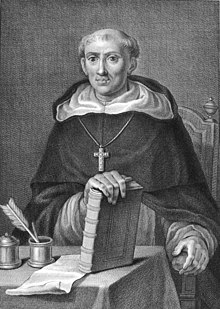
Melchor Cano studied at the University of Salamanca (1527–1531) and became the favorite disciple of Francisco de Vitoria. Cano taught at the Dominican college of Saint Gregory in Valladolid (1533–1542), held the principal chair of theology at the University of Alcalá (1542–1546), and succeeded his mentor Vitoria at the University of Salamanca (1546–1552). At Trent, he led the council away from compromise with Protestantism and toward its reaffirmation of the real presence of Christ in the Eucharist, transubstantiation, the sacrificial dimension of the Mass, and private auricular confession. Cano's conservatism also led him to distrust the new order founded by Ignatius of Loyola (1491–1556), the Society of Jesus, which he considered a sectarian movement with heretical leanings. Ever faithful to his mentor, Vitoria—who was one of the principal defenders of the rights of the indigenous peoples of the Americas against their Spanish conquerors—Cano became a formidable opponent of those who considered the Indians inferior beings and "natural" slaves. Cano's chief opponent in this controversy was Juan Ginés de Sepúlveda, chaplain and official chronicler to Emperor Charles V. When Sepúlveda defended the right of Charles to wage war upon and enslave the Indians in Democrates secundus sive de justis causis belli apud Indos (1544), Cano ensured the book's condemnation by the faculties of Salamanca and Alcalá. Moreover, Sepúlveda's defeat at the hands of Cano and other Dominicans in a debate held in Valladolid in 1550 led to the enactment of laws protecting the rights of native peoples in the New World. Awarded the bishopric of the Canary Islands in 1552, he resigned from teaching at Salamanca. Nonetheless, Cano's close involvement with the royal court prevented him from taking up residence there; unwilling to serve as an absentee bishop, he resigned this post in 1554 . His final years were filled with controversy. In 1556 King Philip II went to war against Pope Paul IV—who had allied himself with France—and Cano defended Philip's right to contend against the pope as a temporal ruler. At Rome, Cano was accused of challenging pontifical authority, and though he was twice elected provincial of Castile by his fellow Dominicans, Pope Paul IV refused to confirm him. Cano's most enduring legacy is his contribution to theological methodology. Cano and other representatives of the School of Salamanca sought to enlarge the scope of theology by turning away from the abstract dialectics of Scholasticism and by placing a greater emphasis on ethical concerns. Like all Thomists, Cano defended the capacity of humans to understand or even intuit the truths revealed by God, and he engaged in an exegesis of the ius naturale, or law of nature. Cano's De Locis Theologicis (published posthumously in 1563) owes much to Rodolphus Agricola's De Inventione Dialectica (1548), as interpreted by Francisco de Vitoria. This opus outlines ten sources, or loci, of theology. Aimed squarely against the paradigm of sola scriptura, Cano's theological method sought religious truth in a variety of sources, which included not just the Bible but also oral tradition; the pronouncements of councils, bishops, and popes; the writings of the Fathers; and even the teachings of pagan philosophers and the testimony of human history as interpreted by natural reason. Cano's method was enthusiastically embraced by post-Tridentine theologians, and was taken to greater heights by some of his Jesuit followers in the School of Salamanca; four centuries later such influential thinkers as Joseph Maréchal and Karl Rahner continued to build on its foundations. The spirit of this positive or fundamental theology, as it came to be known, was neatly summarized by Cano in his De Locis: "Whoever constructs a theology unlinked to reason, and measures dogmas through Scripture alone, does nothing for theology, or for the faith, or for humanity."
Luis de Molina
Born in
Francisco Suárez

Francisco Suárez was born at Granada, Spain; his father, a successful lawyer, early destined him for the priesthood. He entered the Jesuits in 1564. After a weak beginning, he soon became a brilliant student at the University of Salamanca, which was then a center of revived Thomism. Upon completing his Jesuit training, he taught philosophy briefly at Segovia (1571–1574); he then devoted six years to teaching theology at various Jesuit colleges. The lecture notes from these courses became a quarry for his later publications. In 1580 he was called to teach theology at the prestigious Jesuit Roman College, where he lectured on the Summa Theologiae of Thomas Aquinas, but because of failing health he returned to Spain and occupied a chair of theology at Alcalá (1585–1593). His last years at Alcalá de Henares were marked by a bitter rivalry with his fellow Jesuit, the more flamboyant Gabriel Vázquez, so Suárez was happy to move to Salamanca, where he taught and wrote until 1597. He spent the last period of his life (1597–1617) at the University of Coimbra, at the behest of Philip II, who wanted to enhance the prestige of the Portuguese university. Suárez's personal life was that of a pious priest and largely uneventful. His health was never robust, and his teaching duties cut into the time he would have preferred to devote to preparing his manuscripts for publication. Many were left only partially revised at his death and were published posthumously; others, most notably his commentaries on Aristotle, were never published. The 1856 Paris edition of his works ran to twenty-eight volumes. Suárez's main philosophical works were his treatise on the soul (Lyon, 1621) and especially his Disputationes metaphysicae (Salamanca, 1597), which enjoyed great popularity (eighteen editions in the century after its publication) not only in Catholic countries but also in Protestant Germany, where it contributed to the renewed scholastic reshaping of philosophy and theology during the age of Protestant orthodoxy. While working within the regnant Aristotelian tradition, Suárez's philosophical works develop their own order of presentation. Written in humanistic Latin, his works are systematic and clear but often prolix; they draw on a wide reading in philosophers from Plato to his own day. His book on metaphysics is noteworthy for rejecting the Thomistic real distinction between essence and existence. The most important of Suárez's theological works were his extensive commentaries on the Summa theologiae of Thomas Aquinas, especially the tracts De Deo Uno et Trino (Lisbon, 1606), De Angelis (Lyon, 1620), De Opere sex Dierum (Lyon, 1621), and De Legibus (Coimbra, 1612). The last of these tracts has been much studied in the twentieth century, and along with the works of Francisco de Vitoria and Hugo Grotius it laid the intellectual foundations of international law. In choosing to write on the Summa rather than Peter Lombard's Sententiae, Suárez was following the precedent set a half century earlier by Francisco de Vitoria at Salamanca and thereby contributed to making Thomism central to revived scholasticism, even though he often departed from the teachings of Thomas on particular issues. Suárez's Opuscula sex (Madrid, 1599) contain his teaching on grace, human freedom, and God's foreknowledge—a set of questions then under bitter dispute by Jesuits and Dominicans. Suárez does not go so far as his fellow Jesuit Luis de Molina in stressing human freedom in the process of salvation. At the request of the Jesuit general Claudio Acquaviva, Suárez wrote a four-volume study of religious orders, De virtute et statu religionis (Coimbra, 1608–1625); much of it was devoted to a defense of the innovations begun by the Jesuits and by other new orders of the Counter-Reformation. His main contribution to anti-Protestant polemics was his long Defensio Fidei catholicae et Apostolicae adversus Anglicanae sectae errores (Coimbra, 1613, partial English translation in 1944), which was largely directed against the oath that King James I demanded from his Catholic subjects. James I had it burned at Saint Paul's in London and arranged for refutations. Its statements about papal power also led to its being burned by the Parlement of Paris, and it provided Gallicans with ammunition against the Jesuits. Suárez was the culmination of the scholastic revival in Counter-Reformation Spain and the greatest and most systematic theologian among the early Jesuits. Few of his works have been translated into English, but a distinctive Suárezian school flourished among Spanish Jesuits into the twentieth century.
Gabriel Vázquez
Gabriel Vázquez was born in
Antonio Pérez
Antonio Pérez Valiende de Navas was one of the most important Spanish theologians of the first half of the seventeenth century. He was born at Puente de la Reina (Navarre) in 1599 and entered the Society of Jesus in 1613. He studied philosophy and theology at the colleges of Medina del Campo and Salamanca, under the authority of Pedro Hurtado de Mendoza and Benito de Robles (1571–1616), an influential teacher of illustrious philosophers such as Arriaga.[14] He then embarked on a brilliant teaching career: first at the Jesuit colleges of Valladolid and Salamanca, and then at the prestigious Roman College, where he succeeded to another major figure of Jesuit theology, John de Lugo, who had just been elevated to the rank of cardinal. After six years of teaching, he was suddenly fired and sent back to Spain, officially because his theories on God and the Trinity were judged ‘unheard of’ and his lectures ‘obscure’ and ‘incomprehensible’.[15] He died of a sudden illness on the road, in the small town of Corral de Almaguer. Pérez had not yet published a single book, but his reputation as a difficult, demanding, and highly original teacher was already made way beyond the classrooms of Salamanca and Rome. Some of his pupils would do their best to publish a couple of posthumous volumes. Everybody referred to him as the ‘extraordinary theologian’ (theologus mirabilis), even the wily Francesco Sforza Pallavicino, his Italian colleague and rival. Despite Pérez's importance, his work has received very little attention, for two reasons. First, because the second grand generation of the Jesuits keeps being overshadowed by the first powerful generation of authors such as Robert Bellarmine, Francisco Suárez, or Luis de Molina, and historians do not sufficiently acknowledge the strong difference between both. Second, due to his untimely death, Pérez's work has been insufficiently printed, and still subsists mainly in the form of thousands of manuscript pages scattered in various Spanish and Roman libraries, even though these manuscripts enjoyed wide circulation in the seventeenth century.
Pérez took over from his master Benito de Robles the general project of ‘staying close to Augustine in metaphysical matters’ (rebus metaphysicis proximum fuisse Augustino; In primam 87a). This is a strong statement: in early modern scholasticism at large, Augustine was a source for almost every aspect of theology, but never for
Pérez's main originality lies in the way he tried to express classical insights of
Sebastián Izquierdo
Sebastián Izquierdo was born in 1601 at
Although Izquierdo is virtually forgotten nowadays, he was an important figure 17th-century philosophy. Izquierdo was a follower of the Spanish medieval
Historians of mathematics remember Izquierdo especially in connection with combinatorics, to which he devoted Disputation 29 (De Combinatione). He was the first to discuss the number of k-combinations from a given set of n elements.[18] Izquierdo influenced several contemporary philosophers, such as the Spanish Juan Caramuel and Tomás Vicente Tosca and the German Gaspar Knittel and Gottfried Wilhelm Leibniz; the latter, in particular, quoted the Disputatio de Combinatione, in his De Arte Combinatoria (1666). The Disputatio 29 «De Combinatione», was rescued from oblivion and studied in depth by the Jesuit historian of philosophy Ramón Ceñal, who not only translated it from Latin but also carried out an exhaustive study of it published by the Instituto de España.[19]
Juan Caramuel y Lobkowitz
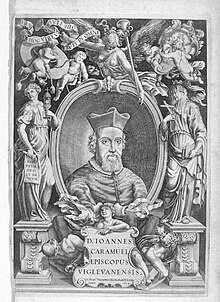
Juan Caramuel y Lobkowitz was born in 1606 in Madrid, to parents of Luxembourgish, German, and Bohemian ancestry. He was educated at the universities of Alcalá and Salamanca, mainly by orthodox Thomists such as the Dominicans
Caramuel was the perfect incarnation of the Baroque polymath and most biographers refer to him only with superlatives. A restless writer, he published ‘a volume of books equal to the years of his life’, as his epitaph says. His interests ranged from grammar and natural languages to architecture, astronomy, and music. A substantial part of his publications was dedicated to philosophy and theology. Caramuel was the first to coin the expression ‘fundamental theology’: he believed that theology as a science must be based upon axioms (fundamenta), both speculative and practical, from which one could deduce various consequences. The speculative axioms are those which confer certainty on the human mind: among these, we find human liberty, God and his revelation as first truth, the certainty and infallibility of the Roman Church, the truthfulness of the pope, the congregations, and the rota, and also the definitions of the major universities and scholars, down the authority of demons, sense perception, and probable opinions. The practical axioms are founded in divine and human authority, and Caramuel treats them according to the Aristotelian table of categories (discussing for instance the quality and quantity of law). Although educated in the Thomist tradition, Caramuel firmly believed in the humanist ideal of nullius addictus iurare in verba magistri (‘not to swear slavishly by the words of any master’). He refused to be enrolled in a specific school of thought and felt free to choose among all the authorities that would best suit his project of constructing a renovated Christian philosophy.
The counterrevolutionary school
Juan Donoso Cortés

Juan Donoso Cortés (1809-1853) belonged to the first
Donoso saw the choice facing Europe after the 1848 revolutions as either the dictatorship of government or the dictatorship of revolution. He incorporates into his thought the dialectic of revolution and counterrevolution which from 1789 to 1848 offers several stages: the French Revolution and the counterrevolutionary reaction, the attempt at a liberal synthesis, and the rise of socialism as an extreme form of revolution. Donoso experienced the liberal attempt at synthesis and reacted against it and against upcoming socialism by returning to the response of the first counterrevolutionaries, especially that of Louis de Bonald and Joseph de Maistre, which he applied to a new phenomenon, that of the third stage of the dialectic, the rise of socialism in the 1840s.
See also
References
- ISBN 9780791486948.
- ISBN 9780813149677.
- The Stanford Encyclopedia of Philosophy.
- ^ Abellán y Mallo, J. L. y T. (1991). "La Escuela de Madrid. Un ensayo de filosofía". Asamblea de Madrid. Madrid: 15.
- ^ Abellán y Mallo, J. L. y T. (1991). "La Escuela de Madrid. Un ensayo". Asamblea de Madrid. Madrid: 47.
- ^ Fernando Savater: Un jubilado jubiloso Archived 2012-06-16 at the Wayback MachineHistorias en http://www.domingoeluniversal.mx,10.06.2012;acesso 03.02.2019
- ^ Montalembert, Charles F. Les Moines d'Occident depuis Saint Benoît jusqu'à Saint Bernard [The Monks of the West from Saint Benedict to Saint Bernard]. Paris: J. Lecoffre, 1860.
- ^ Jacques Fontaine, Isidore de Séville et la culture classique dans l'Espagne wisigothique (Paris) 1959
- ^ Houston, Keith. "The mysterious origins of punctuation". www.bbc.com. Retrieved 2022-09-13.
- ^ Bonnie J. Blackburn and Leofranc Holford-Strevens, eds., in Florentius de Faxolis, Book on Music (Harvard University Press, 2010), p. 262.
- ^ Michael Haren, Medieval Thought (1985), p.148.
- ^ For a more recent defense of the identity between Petrus Hispanus and Pope John XXI, see the preface of W. Degen and B Bapst (2006), Logische Abhandlungen, Munich.
- ^ Bourke, Vernon J. (1967). "Vasquez, Gabriel (1549–1604)". In Edwards, Paul (ed.). The Encyclopedia of Philosophy. Vol. 8. pp. 235–236. Retrieved 12 October 2023.
- ^ For more on Robles see: Schmutz, Jacob (2006). "Réalistes, nihilistes et incompatibilistes". Cahiers de Philosophie de l'Université de Caen. 43: 146–7.
- ^ See Pérez’s Apology in Responsio P. Perez ad puncta sibi data, Salamanca BU, ms. 206.
- ^ Díaz Díaz 1980, p. 345.
- ^ ISBN 9781136353611.
- Knuth, Donald Ervin (2006). The Art of Computer Programming, Volume 4, Fascicle 4: Generating All Trees: History of Combinatorial Generation. Boston: Addison-Wesley Professional. pp. 60–61.
- ^ Ceñal, Ramón (1974). La combinatoria de Sebastián Izquierdo. Madrid: Instituto de España.
Bibliography
- Novotny, Daniel (2013). Ens Rationis from Suarez to Caramuel: A Study in Scholasticism of the Baroque Era. New York: ISBN 978-08-23-24476-8.
- Jörg Tellkamp, ed. (2020). A Companion to Early Modern Spanish Imperial Political and Social Thought. Leiden: Brill. ISBN 978-90-04-42188-2.
- Harald Ernst Braun; Erik De Bom; Paolo Astorri, eds. (2021). A Companion to the Spanish Scholastics. Leiden: Brill. ISBN 978-90-04-29696-1.
